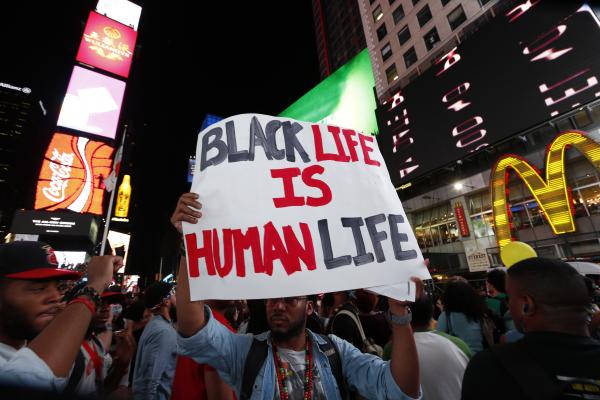One month ago, the city of Ferguson, Mo., was violently shaken by the shooting death of an unarmed black man whose name is Michael Brown, Jr.
This is not the first time we’ve stood in this place. Michael Brown has been added to the roll call of unarmed black people killed by those hired to protect and to serve. His name joins the names of:
John Crawford, an unarmed Ohio man gunned down inside of a Walmart while examining a toy gun sold in the store.
Eric Garner, an unarmed New York man killed, after stating several times that he was having difficulty breathing, by an officer using an illegal choke hold.
Sean Bell, an unarmed New York man shot multiple times outside of the venue for his bachelor party the night before his wedding.
Oscar Grant, an unarmed Oakland man who was handcuffed, face down, before he was fatally shot.
And so many more black lives, both male and female, ended by the reflexes of a legal system designed to police some and protect others.
So why did the killing of Michael Brown, Jr. ignite such a firestorm of rage in a region and a nation where slain black bodies are commonplace?
This is not one of those neighborhoods that cause political analysts to pontificate over “how something so tragic could happen here.”
These are not deaths that leave communities and congregations struggling to find deeper meaning and psychological factors that might have contributed to the tragic loss of life.
As a matter of fact, since the death of Michael Brown, there have been two killings of black men with documented mental challenges, Ezell Ford of Los Angeles and Kajieme Powell, killed only a few miles from the site of Michael Brown’s death. Yet there have been no roundtable discussions of the role of mental illness in our society sparked by these deaths.
What made Michael Brown’s death different?
Why has the death of Michael Brown caused the outrage that has awakened us from our collective stupor marked by years of desensitization to the moral decay that permeates the atmosphere of America?
I contend it was the blood that did it.
His blood exposed, once again, the moral crisis of this nation and revealed the true enemy of a just society: racism.
The blood oozing from the dishonored body of an 18-year-old unarmed black man, saturating the pavement, while he lay uncovered in the street for nearly four hours was a public commentary on the value this nation places on black life.
His blood escaped the public sanitization that often accompanies such scenes.
His blood exposed the brokenness of a humanity that allows God’s children to see one another, not as brother and sister, but as the other to be feared.
His blood revealed the pervasive assumption of guilt that is the black man’s burden in America.
His blood cried out against the insidious effects of racism that result in the criminalization and dehumanization of black bodies slain.
His blood unveiled the chasm that exists between a disenfranchised young generation and a disconnected church.
His blood reminded us of how quickly we can become disconnected from our common humanity and common concern.
His blood provided needed commentary on the self-mutilating, self- annihilating behaviors that have infected our communities of color.
His blood refused to let us ignore the intersections of race and poverty and hopelessness.
The blood of Michael Brown arrests our moral consciousness and exposes the insidious effects of racism that are intrinsic to the very fiber of our nation’s being.
The question is, “What will be our response?”
Rev. Traci D. Blackmon is pastor at Christ the King UCC in Florissant, Mo.
Image: Demonstration in New York on Aug. 14. a katz / Shutterstock.com
Got something to say about what you're reading? We value your feedback!
